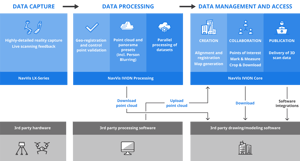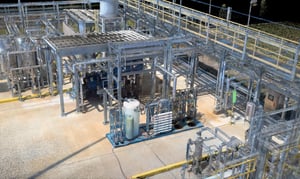
Industry-leading wearable and handheld laser scanning systems
Our cutting-edge mapping technology enables you to capture detailed, survey-grade data in a variety of environments, both indoors and outdoors.
One source of truth
NavVis technology significantly enhances data capture and management workflows in surveying, architecture, engineering and construction. Boost your efficiency without compromising on accuracy, and benefit from the ease of handling and integrating complex spatial data across various applications.
One source of truth
NavVis technology significantly enhances various architectural and engineering workflows by offering seamless integration with widely-used third-party solutions. The core value and benefits of NavVis technology, particularly its point cloud data, can be summarized as follows:
Overall, NavVis technology and its point clouds offer a comprehensive solution that enhances the efficiency, accuracy, and ease of handling and integrating complex spatial data across various BIM and GIS applications.




NavVis seamlessly fits into existing workflows with third party solutions


... and more
NavVis IVION provides seamless integration and effortless workflow compatibility right at your fingertips. A wide array of downloadable data formats is available to fit into your existing workflows and third-party solutions. Moreover, we simplify the export and import of Points of Interest (POIs) using universally compatible .json and .csv file formats, guaranteeing a smooth and efficient data transfer process. Explore the simplicity of integrating our point cloud data formats into your projects to enhance productivity.
Exportable formats:
.e57
.las
.ply
.rcs
.pod
From data capture to project delivery
NavVis technology helps you build a fast yet accurate workflow and deliver high-quality results. See how it works—from capturing reality with NavVis VLX and NavVis MLX to uploading and processing data in NavVis IVION, to drawing or modeling in third-party software, and more.
From the initial data capture to the final delivery
NavVis technology seamlessly integrates into your existing workflows, resulting in a hybrid solution that’s fast, accurate, and delivers quality results. See here how we take you step by step - from data capture with NavVis VLX to uploading and processing data in NavVis IVION to modeling the data in 3rd party software.
Innovative workflow from NavVis to PointFuse to Autodesk Revit
IBKS tested their innovative scan-to-BIM workflow in a huge, complex healthcare facility, a project of over 450,000 sqft. Learn more about their success in combining NavVis technology with PointFuse and Autodesk Revit.


"We have found that we can save a lot of time when modeling from point clouds to BIM models using NavVis IVION. We estimate at least 10% time saving during this process."

Ready to dive in?
Chat with an expert
Our experts speak your language
Simply fill out the form below, and one of our colleagues will be in touch shortly.
Talk to us to discover customized solutions, unique applications, and significant ROI opportunities.
Our experts will clarify pricing details and assist you in optimizing your toolkit and services.
And if you would like a demo, don't hesitate to request one!
“With NavVis VLX, we can race through different floor plates, building sizes, complexities. We’ve had a lot of success with it. We now have four NavVis VLX in operation, every day, 5 hours a day, producing around one to one and a half million sqft of as-built capture per week."
- Adam Fingret, CEO, Extreme Measures Inc.